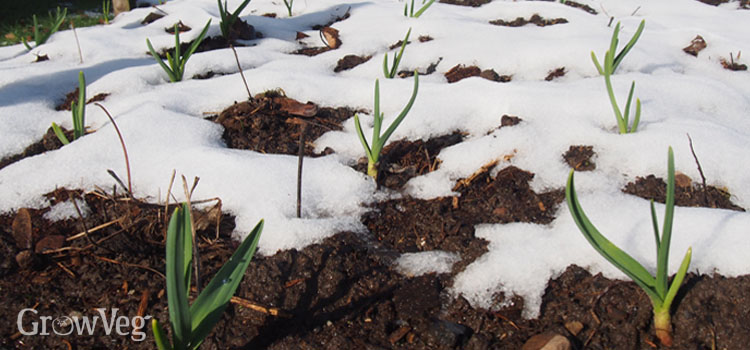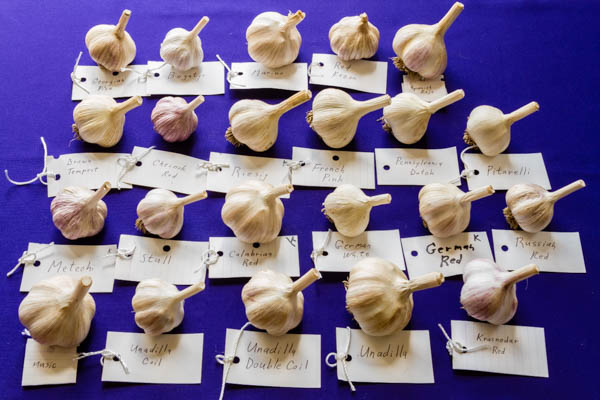If you are wondering what winter garlic and spring garlic is and which are the main differences between them, this article is for you.
When speaking of plant varieties, there are many things to take into consideration. Since each variety changes depending on the specific features of a region, soil quality and nutrients, temperature, among many other factors.
Sampling garlic varieties for next years planting. #garlic #yegfood #yeglocal #supportlocal #yegfarm #thebutternuttree #canadian #garlicbulb #garlicvarieties pic.twitter.com/J57JpOTPd8
— The Butternut Tree (@butternut_tree) October 7, 2019
Garlic, in this case, is a strong plant that is usually grown for cooking matters, as well as health remedies since it has many nutritional and additional properties. It is a bulbous plant that can be grown in two ways: spring and winter. It is quite simple, the type of garlic consists of the planting and harvesting time.
On one hand, spring garlic contains more nutrients, but its cloves are smaller than those planted in winter times, and they are less resistant to frosts. When winter varieties are more yielding and bigger due to the harsh conditions they have to endure.
The following are the main differences and characteristics that we need to know when choosing a garlic variety.

Spring Garlic
First of all, as we already mentioned, this variety is planted in springtime. It has a complex egg-shaped bulb, which consists of cloves covered by a thin film. In these varieties, the number of teeth is greater, and they are randomly arranged since they have no stem in the middle.
To identify a spring variety from a winter variety, you should now that spring garlic is the size of a small onion, has a many teeth, up to 30 cloves, which are located in a spiral in several rows and with no apparent order since there is no stem in the middle to hold them together. The flesh is dense and therefore suitable for long-term storage without losing its qualities.
For spring garlic, moisture saturation of the ground plays a very important role as well as drainage, since rotting can be obtained from excessive moisture. It is crucial to prepare a bed of water before planting, and plant garlic in a damp ground. Light, loamy soil is best for spring garlic and even better if it is enriched with organic matter such as compost.
Rainy weather will accelerate ripening, while dry and hot weather will slow down the process. Also, the yield is affected by the nature of storage in winter: if the bulbs are stored at a temperature of 18 degrees and above – the garlic will grow large, but it will mature longer. And when stored in a cool place at about 5 degrees – the plant will be small, but the crop will ripen earlier. Therefore, some gardeners recommend putting saplings in a cool place a month before planting.
Although there are many varieties of spring garlic, here are the gardeners favorites:
- Abrek
- Kledor
- Yelenovsky
- Aleisky
- Victorio

Winter Garlic
In cold climates such as Canada, Russia or Germany, most garlic crops are planted in the fall because the plant requires a natural dormant period that includes exposure to cold temperatures. Therefore, when the garlic is planted before winter, it puts down roots until the weather reaches freezing temperatures and then waits until next season to continue growing. This fall growing period allows the garlic to get an advantage and then grow outstandingly once temperatures warm up. Gardeners, as a rule, prefer this type for its taste and ability to take root.
Winter garlic has external differences: in size, it is like a large onion, consists of several big teeth (6-10 pieces), which are located evenly around the stem. There are three ways in which it can be planted: prongs, single-edged bulbs (grown from aerial onions) and aerial onions.
Growing winter garlic is easy, but there are a number of features needed to have a great crop. The soil should be fertile, so it is better to choose loamy or sandy; acidity of the soil should be neutral and Garlic can be planted both separately or next to other plants without affecting them.
The main varieties of winter garlic that can withstand almost freezing temperatures are:
- Winter Komsomolets
- Zubrenok
- Novosibirsk
- Alkor
- Garkua
- Garpek
- Hermann
- Gribovsky anniversary
- Komsomolets
- Lyubasha
- Messidor
It is important to pay attention to the ripening period and relate it to your local weather conditions.
Garlic has powerful #immune supporting capabilities that have been shown to boost the disease-fighting response of white blood cells in the body when they encounter viruses, such as the viruses that cause the common cold or flu
Add #garlic to your daily diet. #immunity #health pic.twitter.com/u4ZQGxNyqb
— Shakeel Ahmad (@ShakeelPakhtun) July 12, 2020
Which variety should you choose?
Consider the following points when choosing a variety:
- If safety is a priority, think of deciding on a spring variety. The weather is milder and there is almost no risk of losing the crop in the spring.
- Determine the season you need to harvest your garlic in order to decide which variety suits you best.
- If the size of your garlic is important, winter garlic is larger than spring garlic.
- If you want more nutrients, choose spring garlic as it is believed to be more beneficial and nutritious.
- Consider that each type has a specific storage time. Therefore, define how long you are going to need to store your garlic and choose the variety accordingly.
It is important to know that no variety is better than other. Each type has advantages, disadvantages and unique features that would help us choose the one that fits best for our region, temperature and soil characteristics.
Any of these species is good in its own way, therefore knowing the differences of spring garlic from winter, you can easily choose the most optimal option for yourself.
